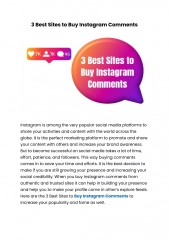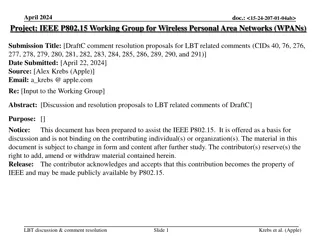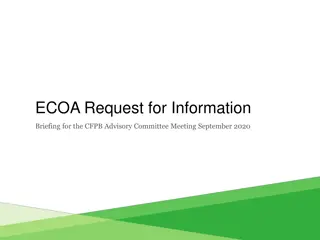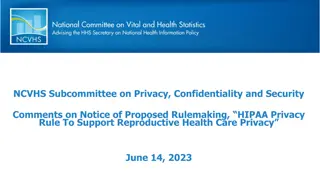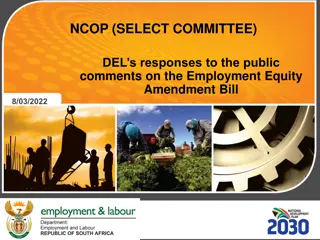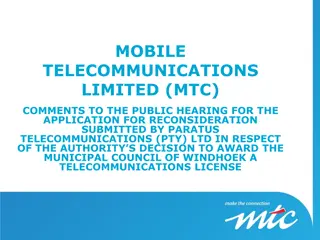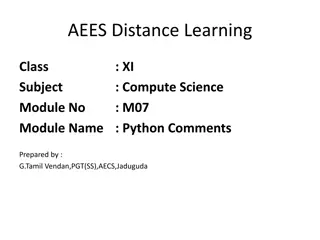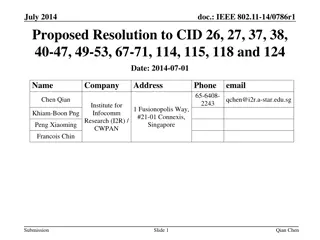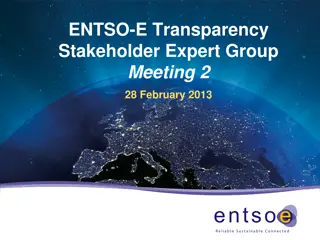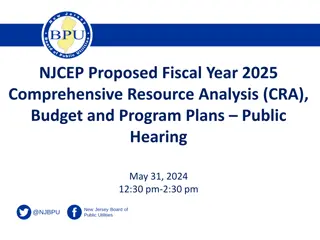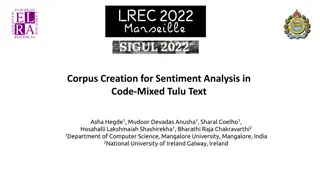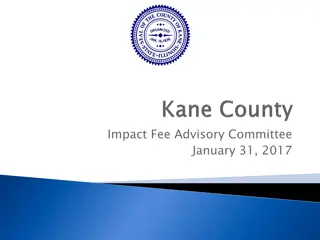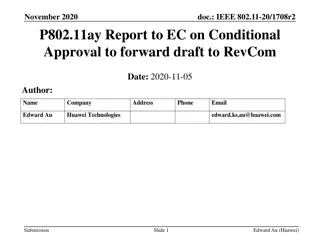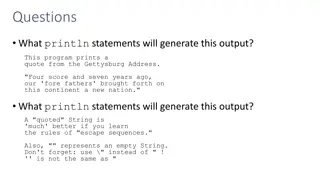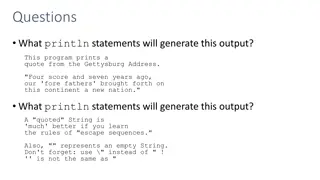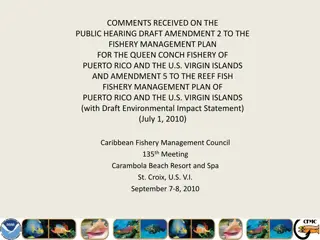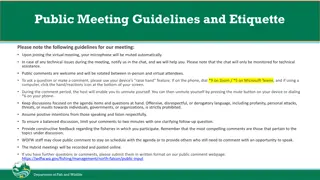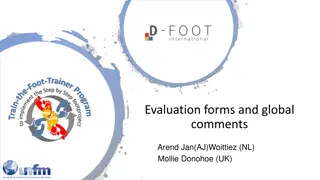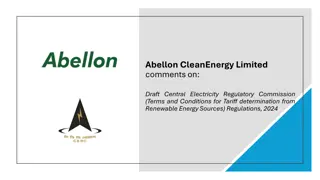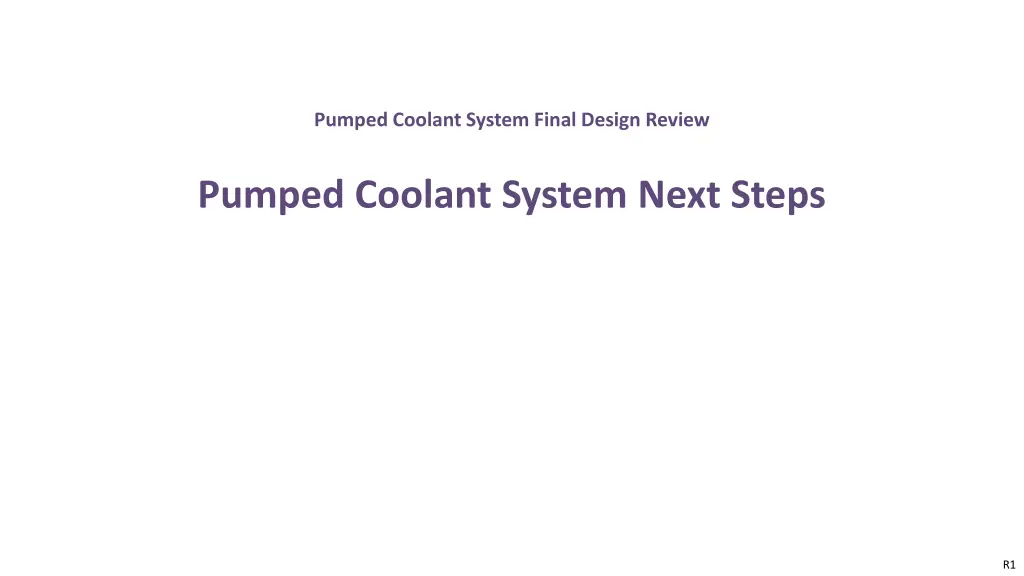
Pumped Coolant System Final Design Review and Next Steps - Recommendations and Preparations
Delve into the final design review of the pumped coolant system and discover the key recommendations including evaluations before procuring equipment, failure modes analysis, readiness reviews, and integration preparations. Get insights into critical considerations for ensuring the system's optimal performance and safety.
Download Presentation

Please find below an Image/Link to download the presentation.
The content on the website is provided AS IS for your information and personal use only. It may not be sold, licensed, or shared on other websites without obtaining consent from the author. If you encounter any issues during the download, it is possible that the publisher has removed the file from their server.
You are allowed to download the files provided on this website for personal or commercial use, subject to the condition that they are used lawfully. All files are the property of their respective owners.
The content on the website is provided AS IS for your information and personal use only. It may not be sold, licensed, or shared on other websites without obtaining consent from the author.
E N D
Presentation Transcript
Pumped Coolant System Final Design Review Pumped Coolant System Next Steps R1
FDR recommendations R1.1 Prior to procuring the 2nd chiller evaluate the following: trapped coolant volume reliefs are incorporated to relieve trapped volumes in the chiller cabinet considering fault conditions such as the heater is on but the pump is off and valves are closed, and verify pressure set points for HBP2 pump bypass valve and Clean Dry Air (CDA) fill valve ZZ15760. Boyd and Brian Q. are evaluating this. The plan is to add an external to the chiller pressure relief valve to address the trapped volume. 1st one retrofitted by SLAC, second one by the vendor. R1.2 Prior to procuring the s-bend and spiral wrap hose: evaluate (using a mock-up and/or prototype) the wrap motion where the s- bend hose connects to the spiral wrap to ensure the motion stays within the stay clear, evaluate if an additional support is needed at the end of each flex section to define the flex motion. We will have a test fixture setup to test with the real lines as soon as they arrive (long lead) since we cannot test without the lines. Martin. R2.1 Document a Failure Modes and Effects Analysis (FMEA) for chiller and circulation system to help define CCS and other operation requirements. These should be started as early as possible and need to be complete before operation with the camera in Chile. Diane can collect what can go wrong and Boyd/Brian can check on what happens when specific CCS shutdown commands are sent or what should be sent. Margaux to send the template to Diane. Needed draft for JSR and completion for December operation at SLAC R2.2 Perform necessary analysis to verify cabinet load (with people and utilities) can be carried by the cabinet, brackets, and the truss. Complete this analysis prior to procurement of the cabinet. Use an ICD to help with this process and study the following: Relative thermal contraction due to the difference in CTE between the steel support structure and the aluminum cabinet. Gravity loading including people and utilities Seismic loading and structural resonance Martin will do the cabinet analysis and Doug will do the truss (use the two secondary beams with worst case load - seismic). The result from the analysis will settle the aluminum versus steel for the cabinet. LSE-80 should be updated to reflect the loads (100lbs/sqf). Jeff B. to send the requirement to Martin and Diane to add to LSE-80 as part of a new LCR. Needed for the JSR Pumped Coolant System Final Design Review Aug 2-4, 2022 2
FDR recommendations (cont.) R3.1 Proceed with approval of BCR-023 and proceed with fabrication and integration after addressing recommendations from other subcommittees. Vincent will take care of this with DO-HEP R4.1 Prior to the start of Camera installation, conduct an internal Installation Readiness Review. Yes, it is part of the plan. It is planned for April 2023. Vincent and Kevin will organize. R4.2 Prior to procurement of the chiller cabinet, compose an Interface Control Document defining the interface between the chiller cabinet and the telescope structure. John A. will make a new drawing (LSE document). Doug will push the creation of an LCR for this. R4.3 Before the Installation Readiness Review, add Integration and Commissioning Risks and Mitigations to the risk registry. Kevin R. will add integration and commissioning risks to the registry. Needed before the JSR. R4.4 Before the Installation Readiness Review, storyboard the integration process and identify/categorize all lift operations; identify hazards; identify key pause points during the process for QA/verification; identify necessary procedures, fixturing/tooling/supplies. John A. will do a story board for installation of the lines and how to lift and install with scaffolding, orientation of telescope and the bracket. Lower priority (to be done after the interface items are done post JSR). Boyd to develop the procedures for capping, bayonet install and testing the joints are installed correctly. Martin will work on the oancake wrap story board and Shawn on the spiral wrap story board. Pumped Coolant System Final Design Review Aug 2-4, 2022 3
PCS General work to do R2.1 Document a Failure Modes and Effects Analysis (FMEA) for chiller and circulation system to help define CCS and other operation requirements. These should be started as early as possible and need to be complete before operation with the camera in Chile. R4.1 Prior to the start of Camera installation, conduct an internal Installation Readiness Review. R4.3 Before the Installation Readiness Review, add Integration and Commissioning Risks and Mitigations to the risk registry. R4.4 Before the Installation Readiness Review, storyboard the integration process and identify/categorize all lift operations; identify hazards; identify key pause points during the process for QA/verification; identify necessary procedures, fixturing/tooling/supplies. Pumped Coolant System Final Design Review Aug 2-4, 2022 4
PCS General comments Consider any conditions where the cold plate electronic or cold plate heaters can be on when the cooling system is off. A hardware switch such as a klixon in series with the cold plate heaters could prevent an accident overheating condition. We have 4 RTDs that are fed to the master protection system PLC that trips the heaters when the temperatures gets too hot. Consider including in LCA-19243, pumped coolant system operations plan, a list of permits, warnings, and alarms sent to telescope operators and conditions that would fault other camera systems based on the chiller faulting. Include a list of what conditions would stop the chiller system including chiller self protection and any external signals that would stop the chiller. Include conditions such as if the vacuum is poor in the camera or other telescope fault conditions. Tony will add this to the document after we receive the manual. Consider including a complete FMEA for the pumped coolant system to go through all failure scenarios such as low liquid level, loss of ethernet communications, power failures, poor vacuum conditions in the Transfer lines, or loss of vacuum in the camera region which could cause condensate to accumulate, internal chiller heater stuck on. Already part of the recommendation. It would be beneficial to develop the resource and installation related risks to better understand their impact to the personnel/instrument safety and installation schedule. Done as part of the risk recommendation by Kevin The project may want to evaluate what impacts Novec leaks would have on energized electronics and on lubrication that could be exposed to them and mitigate such risks if appropriate. Brian to search literature for impact on electronics components and write a summary. Same for oil of motors (if it drops on a motors ,such as fans, will it interact and dissolve the oil causing the motor to seize up) ICD LSE-64 should explicitly state the required available flow rate of compressed dry air. If there is a requirement on stability of the delivered pressure, then this should also be documented. Boyd and Brian Q. should provide the flow rate and Diane will update the LSE-64 to add this. Let s pick the flow rate needed to pressurize the tank in ~5min. Doug and Diane to take the stability offline. We can ask for 32 gallon of CDA at 50 psi in 5 minutes. Pumped Coolant System Final Design Review Aug 2-4, 2022 5
PCS General comments (cont.) The PCS team should assess whether 10 gpm of facility coolant is actually required for the PCS and if appropriate, update the requirement to reflect the actual need, which may avoid substantial facilities work to up-size that piping. Brian and Boyd are evaluating with a chiller. We should incorporate with the pending LCR for LSE-64/65. We will hold the approval for 4 weeks or so. Risks for the Integration and Commissioning phases should be identified and added to the Risk Registry, with mitigations planned where appropriate, especially considering the impacts of possible delays. Possible risks include damage to hardware, unexpected integration issues, shipping, availability of personnel, hardware availability sequencing, supply chain (e.g. Novec), etc. Possible mitigations could include procurement of spare elements of the piping runs and procurement of generic hose runs that may be used to bridge lengths of the coolant runs in case of failure or mis-fit of the baseline hoses. Already addressed by Kevin through the recommendations A storyboard of the steps in the entire integration and commissioning process would be very helpful for internal planning, presentation to reviewers, identification of risks and hazards, identification of needed fixturing/tooling/supplies, documentation of prerequisites for each integration activity, and documentation of verification/QA activities. Already addressed b John with the recommendation. Pumped Coolant System Final Design Review Aug 2-4, 2022 6
Pancake Wrap work to do Decide on low friction sleeving and walls and floor material Modify lid and screw locations for clearances Develop template and drill jigs for CCW retrofit Mock up bayonet connections to test access and clamping Decide on surface coatings and color Draft part and assembly drawings Review clearances, retrofit, and mounting plans with Summit team Procure parts MRR on assembly, test, and integration plans Update frame for assembly, test, and transport Pumped Coolant System Final Design Review Aug 2-4, 2022 7
Transfer lines and routing work to do Finish generic and custom support designs and analysis Finalize line routing Look at shipping and re-gen sizes Decide on sparing and re-generation Draft line drawings Decide on fill-in flex lines Decide on bayonet close-outs and testing/purge configurations Decide on gauge read-outs and access for pumping Procure all transfer lines Develop plans and templates for support mounting Develop integrator and test straw-man to refine work plans and processes MRR on retrofit and install plans Pumped Coolant System Final Design Review Aug 2-4, 2022 8
Transfer lines and routing comments Consider implementing the remote monitoring of the vacuum jacket pressures. IR camera monitoring plus monthly measurement with easy access does not warrant the full remote monitoring cable routing necessary. We should wire the ones that matter (top end) likely 6 items to monitor to a hub. Joh A. will look at this. Consider adding a second pumpout port on each of the longer transfer lines which would allow leak testing the other pump out and reduce the pumpdown time by allowing pumping from both ends. This also allows daisy chaining lines for joint pump down. This does not apply to the cryoworks line second pumpout port is not needed. We have received information from the vendor showing that only lines over 50 feet need a second pump port. For Lines #7; Consider machining plates with tapped holes for supporting the hose cradle vs tapping holes in situ. These plates can then simply be welded to the TMA Spider Vanes that would of been tapped. Also the CAD figure that was shown had 6 V-shaped mounts consider reducing this number. Finally It is not clear if using the cover to secure the line from sliding down the Spider Vane is the best thing vs using a real pipe clamp or two. Can the VJ be coated directly and get rid of the cover? John and Doug will write a response to this comment Planning for the installation of the vacuum jacketed lines has begun and is an important part of the final design process. Some of the leadership positions for oversight of this work are vacant now. This type of complex installation work often has a storyboard to illustrate the work steps and help visualize interferences and highlight access issues. The committee thinks an installation storyboard would be useful. (see Recommendation R4.4) This is a project office item. The performance of the coolant transfer lines is critical to the operation of the system. Each segment of the vacuums should have a vacuum sensor, and the data from these should be continuously and automatically written into a database for easy access. Consider preparing equipment to temporarily pump the vacuum space if vacuum pressure starts to rise until a convenient time for replacement is available. Consider obtaining up-front spares for any lines that flex with telescope motion, e.g. the lines that pass around the elevation axis. John A will review what can be specified as a set of flex lines + adapters to cover temporary issues. Vincent will work with DOE-HEP on cost considerations for this. Pumped Coolant System Final Design Review Aug 2-4, 2022 9
Transfer lines and routing comments (cont.) During installation of the vacuum jacketed lines QA check will need to be done. It would be best to be able to perform tests on individual sections before the installation is complete. Bayonet ends of each type should be available to allow such testing. It could be useful to have available a fully flexible line long enough to replace a section if a section needs to be temporarily replaced for any reason. This line may not need a vacuum jacket, but be a lower cost flexible installation. Addressed in recommendations Consider procuring jumper bypass hose with appropriate end fittings to enable operation and testing of the cooling loop as it is being constructed and prior to final plumbing to the cryostat. Addressed in last page The interface between the PCS plumbing and the telescope structure may not require a formal ICD. However, the recommended storyboard should capture key features and installation details to ensure successful integration Key assumptions about fit should be verified across the team prior to finalizing the hose designs. Addressed in recommendations Pumped Coolant System Final Design Review Aug 2-4, 2022 10
Spiral Wraps and Manifolds work to do R1.2 Prior to procuring the s-bend and spiral wrap hose: evaluate (using a mock-up and/or prototype) the wrap motion where the s-bend hose connects to the spiral wrap to ensure the motion stays within the stay clear, evaluate if an additional support is needed at the end of each flex section to define the flex motion. Decide on whether we should build a prototype before ordering final wrap flex lines Procure bayonet flange Draft manifold part and assembly drawings Procure manifold parts MRR on manifold assembly, test, and integration plans Procure wrap parts Design wrap assembly and test jig MRR on wrap assembly, test, and integration Pumped Coolant System Final Design Review Aug 2-4, 2022 11
Spiral Wraps and Manifolds comments The spiral flex and s-bend flex connections are joined but the joint is not supported. Evaluate if a support is needed at that location to help define the flexure motion. A restraint on the elbows between the S and spiral hose will likely better define and constrain the hoses thus designing and machining parts to allow these to be installed if they are needed will save time and time is critical on this project See recommendation on this. Will be reviewed as part of the test within the recommendation Vented hardware is being used in the vacuum space, but it looks like there may be a PEEK block with holes to reduce heat leak but those holes are not vented. Once this is addressed, the manifold should be procured as quickly as possible. Shawn will fix this The pancake wrap has been mocked up and prototyped with good success. The spiral wrap has not yet been prototyped at the same level of detail. SLAC is planning a mock up / test of the spiral wrap with the real lines (fall 2022), any issues could be resolved in winter (2022-2023) to be ready by spring (ship in march 2023). Concerned with the tight schedule to the March 2023 ship date. Clearly document the scope of the spiral wrap test and its acceptance criteria; this will help to avoid scope creep of the test and lead to clear conclusion that can motivate subsequent decisions on the lines and wrap performance Shawn will have a test plan and the prototype work will provide early insights. Pumped Coolant System Final Design Review Aug 2-4, 2022 12
Chiller work to do R1.1 Prior to procuring the 2nd chiller evaluate the following: trapped coolant volume reliefs are incorporated to relieve trapped volumes in the chiller cabinet considering fault conditions such as the heater is on but the pump is off and valves are closed, and verify pressure set points for HBP2 pump bypass valve and Clean Dry Air (CDA) fill valve ZZ15760. Work out external plumbing needed so we can finalize cabinet Test water flow and pressure to finalize glycol needs Demonstrate ability to re-configure lines with coolant in reservoir Update and review spec and SOW for procurement Get updated quote with final spec Update operations manual and procedures Test off-normal operations Get manual from inTest Get servicing requirements and procedures from inTest Procurement review for chiller Order chiller #2 Pumped Coolant System Final Design Review Aug 2-4, 2022 13
Chiller comments The chiller may have internal trapped volumes including a trapped volume near the 1800W heater which should be addressed by adding a pressure relief valve. Addressed in recommendation Chiller mechanical part fluid list shows HPB2 over-pressure pump bypass relief valve 70 PSI crack pressure and the PID 80 PSI crack pressure, and the total system head is 85 PSI. LCA-19243 show a supply steady state operating head of a 100-105 psig and could be as high as 115 psig when the chiller faults. Evaluate what the pressure should be and update hardware setpoint and associated documentation. Brian to write and answer Evaluate what happens if 145psig Clean Dry Air (CDA) is used to backfill the system. Other valves are rated to vent at 125psig. Consider lowering the pressure regulation at the PRV to below the pressure of other pressure relief valves. Reservoir over-pressure control valve on CDA supply line , max Pressure: 145 psi, -20 C to 60 C ambient temp range; Exhibit file 6: Brian to write and answer Consider including how many gallons it takes to fill the system in LCA-19774 filling the system and what reservoir liquid level is considered full. Repeat Steps 3010 thru 3040 to refill the chiller till the chiller tank indicates the tank is full . Ensure during a passive system stop all fluid can drain into the chiller reservoir and not exceed the reservoir volume. Boyd to address this comment Due to the difficulties in procuring Novec, the cooling system design should allow for recovery of as much uncontaminated Novec as possible, whenever draining is required. Provisions should be made for filtering and safely storing recovered Novec, with a traveller indicating the history of the stored Novec. yes Pumped Coolant System Final Design Review Aug 2-4, 2022 14
Cabinet work to do R2.2 Perform necessary analysis to verify cabinet load (with people and utilities) can be carried by the cabinet, brackets, and the truss. Complete this analysis prior to procurement of the cabinet. Use an ICD to help with this process and study the following: Relative thermal contraction due to the difference in CTE between the steel support structure and the aluminum cabinet. Gravity loading including people and utilities Seismic loading and structural resonance R4.2 Prior to procurement of the chiller cabinet, compose an Interface Control Document defining the interface between the chiller cabinet and the telescope structure. Decide on whether an ICD is needed Analyze mounts and hardware Analyze TMA girders Analyze cabinet and decide on steel vs aluminum Add all cabinet contents, including plumbing, electronic chases, transfer lines Finalize plans and designs for lifting, forklifting, shipping, and mounting to ground Pumped Coolant System Final Design Review Aug 2-4, 2022 15
Cabinet work to do (cont.) Modify design per analysis results Draft cabinet part and assembly drawings Agree on locations and routing for glycol, power and shut-off, CDA dFDR on cabinet design Procure cabinet parts Develop plans for loading, moving, shipping, integrating cabinets MRR on cabinet loading, integration plans Pumped Coolant System Final Design Review Aug 2-4, 2022 16
Cabinet comments The chiller cabinet mounts to a structural truss. Analysis of the impact of the cabinet load and associated loads from people during installation and connected utilities needs to be performed. Brackets have been designed for connecting the cabinet to the truss and are in the solid model. Assumed factors of safety and margins of safety for the cabinet and brackets should be appropriate for custom structures that must provide personnel occupancy. Lifting points have not been defined for the cabinet and these will need to be included in the fabrication. Planned as part of the recommendation An Interface Control Document (ICD) that provides the dimension, direct loads, indirect loads, occupancy limits, and utility requirements for the cabinet would be a good tool to help with cabinet verification. Complete all analyses on the chiller cabinet and relay loads to the appropriate team for telescope structure analysis ASAP . New drawing planned The cabinet structural bracket connections would seem to benefit from some shear pins to the truss structure (particularly for earthquake loads), this would reduce loading on the threaded rods used for the brackets. It is not clear the bracket approach is the best method to connect the chiller cabinet to the truss structure. It is understood that there is an effort to avoid modifications to the truss. Drilling through-holes on the truss structure and connecting through it with a bolt and nut would be more robust; it would also be easier to create a properly preloaded joint. For the cabinet support consider adding slots to allow for slight changes in mounting beam locations. Martin with discuss with John aftre analysis is done. Consider welding the flanges Pumped Coolant System Final Design Review Aug 2-4, 2022 17
Cabinet comments (cont. 1) The chiller cabinet lift through the floor is likely a high-consequence/critical lift; an ICD to the floor and truss structure will contribute to the planning and success of this installation: Removal of floor panels creates a safety hazard that will need to be managed during the lift Damage to the chiller/chiller cabinet/truss structure during the lift could cause a significant delay to the project schedule The lifted item passes through a floor where the visibility of the load may become obstructed to the crane operator Load transfer operation from hook to telescope structure This will be planned as category 2 work The cabinet design is a weldment from aluminum tube. Aluminum welds have significantly less strength than the base material. Adding reinforcing plates at the joints could allow taking full advantage of the strength of the members. Testing of the weldment should be considered in the selection of the fabrication vendor and process. Consider using appropriate inserts at tapped holes in the aluminum that are utilized as lifting points; the torque spec on steel hoist rings can potentially strip/damage aluminum threads. Will be reviewed after analysis by Martin. Pumped Coolant System Final Design Review Aug 2-4, 2022 18
Cabinet comments (cont. 2) The exact, as-built geometry of the telescope structure may not be accurately captured in the master solid model. The planned attachment of the chiller cabinet to the AZ floor is by bracketry that has some dependence on the geometry of the AZ floor and may be adversely affected by differences between the CAD model and as-built features, such as the possible presence of weld beads or spatter or non-nominal beam placement. In addition, the planned structural analysis subject to chiller/cabinet weight depends on mounting details and on the mass properties of the supported load. The details of this interface (including geometries and mass properties) should be captured more formally in an ICD, to ensure that the hardware fits correctly and to provide reference documentation for the inputs to the structural analysis. Machined or 3-d printed parts could be test-fitted as well. The mentioned existing handrail below the AZ floor needs to very carefully verified to not interfere. The planned structural / seismic analysis and the passing criteria of the analysis are particularly critical due to the expectation that the hardware is meant to support personnel. Proof testing is encouraged, even if not required by code. The team should consider leaving the chiller panels in place when installed and energized, for personnel safety considerations. The Thermonics chiller on DESI has 440 vac power within the panels. This should be reviewed by an electrical safety SME. Pumped Coolant System Final Design Review Aug 2-4, 2022 19
CCS and Protection work to do Write CCS subsystem manual Update telemetry with all available sensor data from chiller Check on monitoring valve statuses Check on monitoring compressors and pump currents, temps Check on monitoring on-board fault status and alarms Test chiller off-normal operations: PID constant mods, set-point temp change, set-point sensor change, trip and recovery from master protection dropped permit Pumped Coolant System Final Design Review Aug 2-4, 2022 20
CCS and Protection comments The Camera Control System (CCS) will monitor and control the Chiller. The project is planning to monitor and record necessary data to control the system. The committee s experience is that more data really helps during operation with troubleshooting and looking at trends for early detection of problems. Careful definition of the required warnings, alarms, and interlocks to protect the refrigeration unit, coolant transfer lines, and the camera are needed. For example, vacuum would be monitored and loss of vacuum would shut off chiller. This could be included in existing documentation, or preferably a new ICD could be developed. Pumped Coolant System Final Design Review Aug 2-4, 2022 21
Ground Operations work to do Finalize ground testing plans, especially on the cart Finalize cabinet configuration in the MRCR and any retrofits Develop plans for moving, integrating, mounting, and accessing cabinet in MRCR Finalize support designs and mounting plans for routing transfer lines MRR on ground operations plans Pumped Coolant System Final Design Review Aug 2-4, 2022 22

